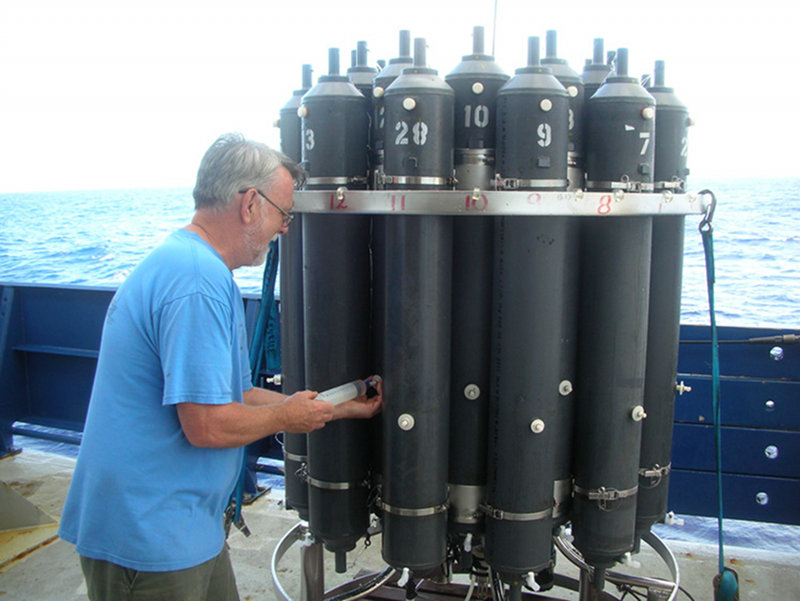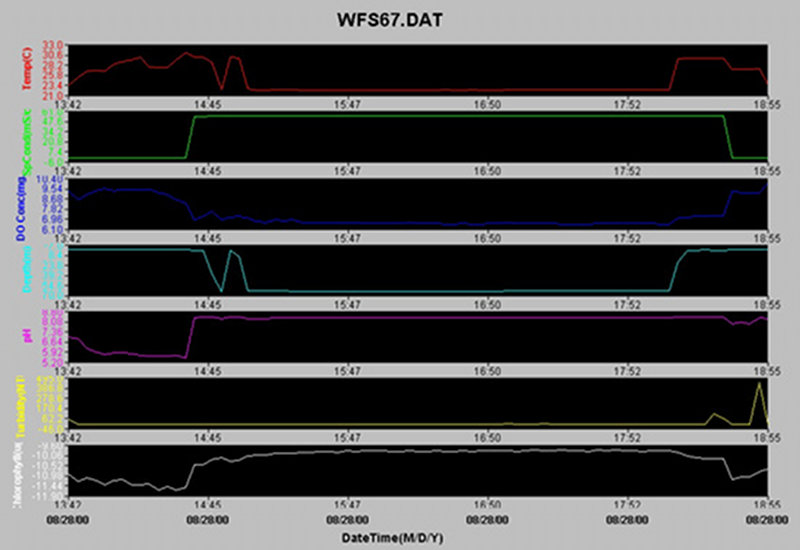Sonde and CTD
Multi-parameter water monitoring systems have been designed to address the emerging need to simultaneously measure a range of biological and physical properties in both fresh and seawater environments. These systems are designed to be used in the field. They operate with the push of a button, store data in memory, and communicate with computers.

Scientist on board R/V Roger Revelle extracts water from one of the sample bottles in the CTD rosette. Image courtesy of NOAA. Download image (jpg, 144 KB).
Profiling the Water Column
One type of instrument package, sometimes called sondes, are ideal for profiling and monitoring water conditions in industrial and wastewater effluents, lakes, rivers, wetlands, estuaries, coastal waters, and the open ocean. Torpedo-shaped in appearance, sondes may have multiple sensors that record a range of water quality data. If the sonde has “on board” battery power, it can be left unattended for weeks at a time, with measurement parameters sampled at preprogramed intervals and data securely saved in the unit's internal memory.
Some sondes can be programmed to sample data as often as once every 4 seconds, and can store up to 150,000 readings. Typically sondes can be deployed to a depth of 656 ft (200 m) and are equipped to measure temperature, conductivity, salinity, dissolved oxygen, pH, turbidity, and depth. Additional ports for measuring chlorophyll concentration may also be present. In the event that a sonde must be deployed to depths greater than 700 ft, the sonde may be placed in a special stainless-steel pressure case.
Upon retrieval from the water, the sonde's information is downloaded to a computer and specialized software is used to graph and interpret the data.
Another water monitoring system similar to the sonde, but simpler in design, is called a CTD (conductivity, temperature, depth). The device’s primary function is to detect how the conductivity and temperature of the water column changes relative to depth. Conductivity and temperature information is valuable because the salinity (the concentration of salt) of the seawater can be derived from these two variables. Light scattering sensors and dissolved oxygen sensors can also be attached to the CTD to collect additional water column data.
Deploying CTDs
Similar to the sonde, the CTD is torpedo-shaped and may be deployed by itself, attached to a submersible, or as part of a larger metal water sampling array known as a rosette, or carousel. Multiple water sampling bottles are often attached to the rosette to collect water at different depths of the cast. Sometimes, the metal frame is attached to a conducting wire and lowered into the water. Information is sent back to the ship along the wire while the instrument is lowered (downcast) to a depth specified by the scientist and then brought back (upcast) to the surface. In other cases, the CTD can store the data collected in its memory, which can be downloaded and analyzed at a later time using software similar to that developed for sondes.

Sondes measure a number of variables in the water column. This data was recorded by a sonde attached to a submersible. Moving from top to bottom in the readout above, the sonde measured changes in temperature, salinity, dissolved oxygen, depth, pH, turbidity, and chlorophyll concentration over the course of the submersible's dive. Image courtesy of NOAA. Download image (jpg, 55 KB).
By analyzing information about the water’s physical parameters, scientists can make inferences about the occurrence of certain biological processes, such as the growth of algae. Knowledge like this can, in turn, lead scientists to a better understanding of such factors as species distribution and abundance in particular areas of the ocean.
